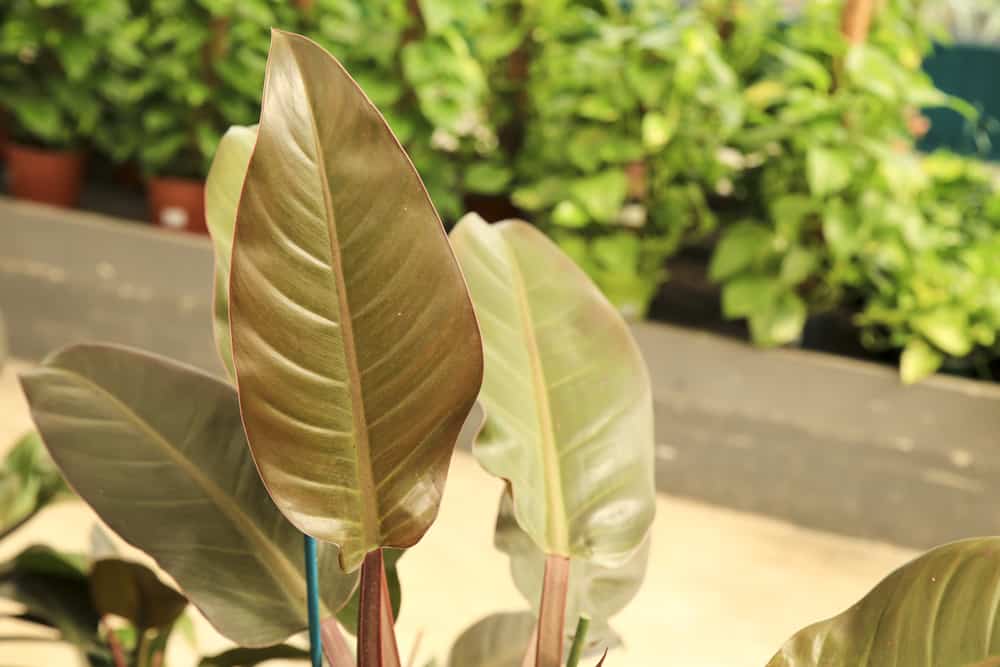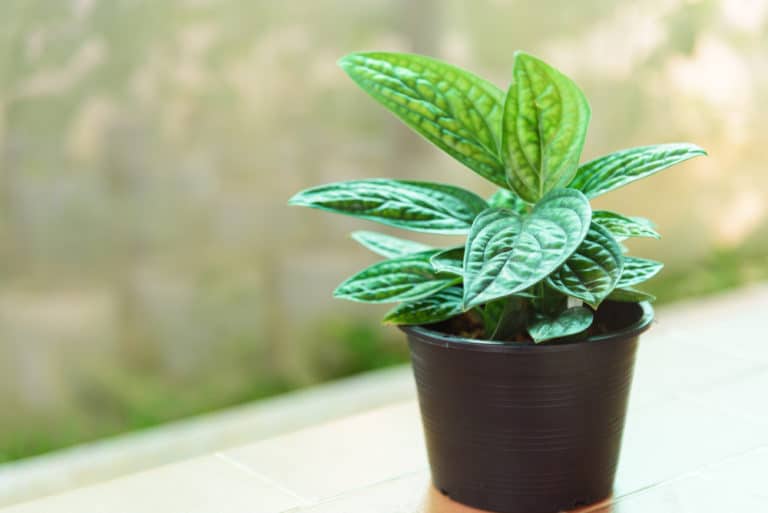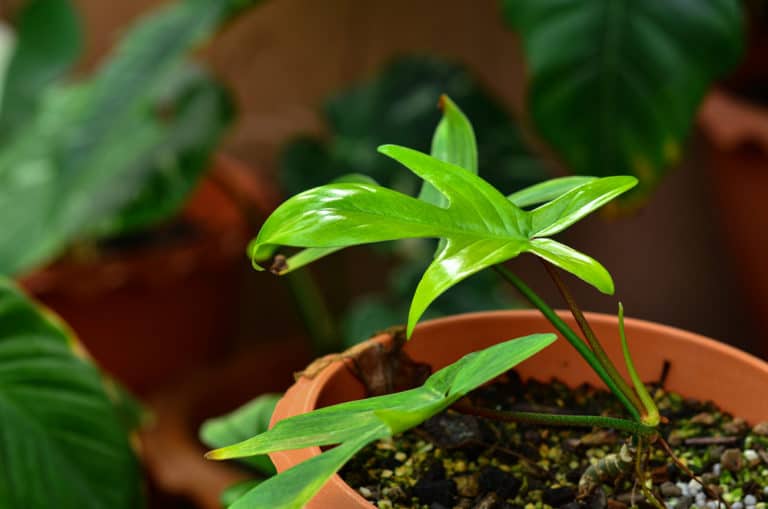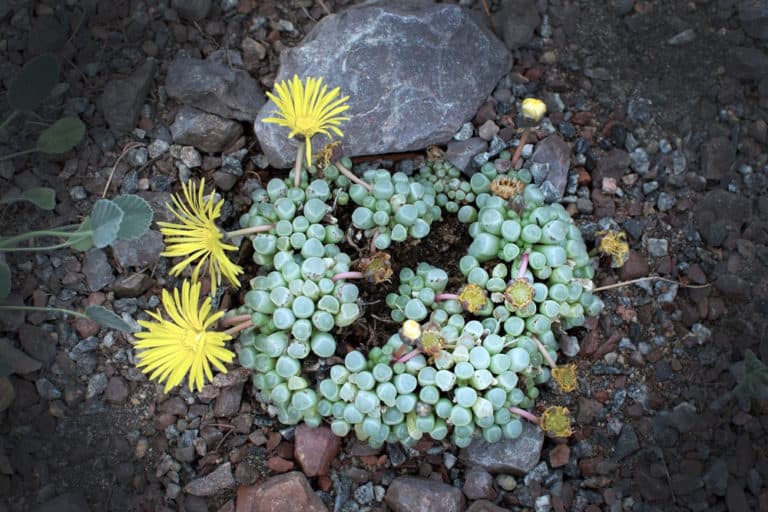Philodendron Erubescens ‘Imperial Red’ Care Guide (2024)

Philodendron Imperial Red is a magnificent tropical plant that will become a star of your indoor garden.
A fairly recent hybrid, Philodendron erubescens Imperial Red has large, leathery leaves sporting shades of dark red and green.
Since it’s a low-maintenance plant, you will be able to enjoy it without having to put in too much work.
| Scientific Name | Philodendron erubescens ‘Imperial Red’ |
| Common Name | Imperial Red Philodendron |
| Light | Bright indirect sunlight |
| Watering | Water if the top half of the soil is dry |
| Temperature | 65 to 80°F (18 to 27°C) |
| Hardiness Zone | 10-11 |
| Humidity | 50-70% |
| Soil Type | Loose, well-draining |
| Soil pH | 6 to 6.5 (mildly acidic) |
| Fertilizing | A balanced feed once a month in spring and summer |
| Repotting | Every 2 years |
| Pruning | Beginning of the growing season |
| Propagation | Offsets or layering |
| Toxicity | Toxic to humans and pets |
| Mature Size | 24 to 36 inches as a houseplant |
| Bloom Time | Late spring, early summer |
What’s Unique About Philodendron Imperial Red?
Philodendron Imperial Red is a hybrid cultivar developed in the 1980s, and it has become very popular for its impressive appearance.
The Philodendron Imperial Red plant is notable for the size and color of its leaves. They can grow as large as 15 inches long, and are maroon and dark green, making it a dramatic addition to an indoor garden.
Philodendron Imperial Red plants, like all philodendrons, are good at clearing contaminants such as formaldehyde out of the air.
In addition, growing Philodendron Imperial Red is very easy, as these plants are undemanding once their simple cultivation requirements are met.
Philodendron Imperial Red Care
Philodendrons are native to the rainforests of Central America and the West Indies. Good
Philodendron Imperial Red plant care tries to replicate as much as possible the conditions in which these thrive in the wild.
Red Philodendron care entails keeping the plants out of the direct sun in a warm, humid environment while keeping their soil on the dry side.
Light
The philodendron originates in tropical rainforests where it grows in the dappled shade cast by the tree canopy.
As a result, Philodendron Imperial Red light requirements are for bright but indirect light, or between 10,000 to 20,000 lux.
The easiest way to meet Philo Imperial Red light needs is by keeping your plant next to north or east-facing window, where the morning light is not too strong.
However, when placing your Philodendron Imperial Red in a south or west-facing room, you will need to keep it out of the full sun, as the more intense afternoon rays can damage its leaves.
Watering
Philodendrons may be native to the rainforests, but that doesn’t mean they are used to sitting in wet ground. The soil there drains quickly, so they need less watering than you might think.
Instead of following a strict schedule, only water Imperial Red Philodendron when at least the top half of the soil is dry.
The need for Philodendron Imperial Red watering will slow down in winter. That’s when the plant enters its dormant phase and uses less water than when it’s actively growing.
Philodendron Imperial Red’s watering needs are best met with distilled or rainwater. If you must use tap water, let it sit overnight to dissipate chemicals like fluoride and chlorine.
Temperature
Philodendron Imperial Red is a tropical plant and it likes it warm. The Philodendron Imperial Red temperature range is from 65 to 80°F (18 to 27°C).
Most homes are maintained towards the bottom half of that range, so you should have no trouble providing that temperature for Philo Imperial Red.
Philodendron Imperial Red has limited temperature tolerance below 55°F (12°C). Exposure to that cold environment will stunt their growth. Avoid placing them in the direct line of air conditioning vents.
These tropical plants have no frost hardiness at all. If you take them outside in summer, bring them in before temperatures start to fall.
Humidity
Rainforests are humid environments, and so the ideal humidity for Philo Imperial Red is over 50% and as high as 70%.
That’s going to be too damp for you to maintain throughout your house. Luckily, Philodendron Imperial Red is very tolerant of the lower humidity level in your home.
However, meeting the ideal Philodendron Imperial Red humidity requirements will pay off in bigger and more beautiful leaves.
You could use a small humidifier to create a small oasis of moist air, or place the pot on a pebbled tray filled with water.
Misting the leaves with a fine spray a few times a week can also help.
Soil
Philodendron Imperial Red soil has to be porous and quick-draining to keep the roots from being submerged in water, which will kill the plant.
The best pH level for Imperial Red Philo is 6 to 6.5, or mildly acidic.
The soil for Imperial Red Philo should also have some nutrients to help nourish the plant.
You can use a commercial cactus soil mix and add some extra peat moss and well-rotted compost to loosen it up and increase the amount of organic matter.
If you want to mix your own, use equal quantities of potting soil or compost, perlite, and peat moss or coco coir.
Fertilizer
You will not need to use additional fertilizer for your Philodendron Imperial Red if you used compost or slow-release fertilizer granules when potting it.
Otherwise, you will need to use fertilizer for Imperial Red Philodendron to keep the leaves large and lush.
Use a houseplant formulation with a balanced fertilizer ratio of 10-10-10.
If you use a liquid product for your Philodendron Imperial Red fertilizer, dilute it to half the recommended strength and apply it directly to the soil. Do not get it on the leaves, and only use it after watering to ensure that it gets absorbed by the soil instead of running out to the bottom.
Potting & Repotting
While Philodendron Imperial Red does not object to being root-bound, you will need to repot the plant every 2 or 3 years. When you find it getting top-heavy or see roots growing out the bottom, it’s time for Philodendron Imperial Red repotting.
When repotting Imperial Red, select a porous pot such as an unglazed clay, which can help dry out soil that has been watered too heavily. The new pot must have drainage holes.
Only go up pot size or at most 2 inches when potting on your Philodendron Imperial Red. Use fresh soil.
Repotting should be done in spring as your Philodendron Imperial Red emerges from its dormant phase.
Pruning
There is not much Philodendron Imperial Red pruning required. It is a self-heading plant, meaning that it naturally forms into a full, bushy shape.
There are only a couple of reasons for cutting Imperial Red.
You always need to trim out any dead or damaged leaves, both for appearance and the health of the plant.
You should only prune healthy leaves if your Philodendron Imperial Red is growing too wide for the available space. If that is the case, remove the largest leaves at the base of the plant. Do this in early spring or late fall.
Always use sterilized scissors or knives to prevent the spread of disease.
Propagation
Philodendron Imperial Red propagation can be done at home by air-layering or separating plantlets from the mother plant.
To propagate Imperial Red from plantlets, you have to be patient and wait for offsets to develop at the base of the plant, against the stem where the oldest leaves have died away.
If they already have their own roots, you can remove them without any further work.
However, if they only have aerial roots, you will need to wrap them in damp sphagnum moss, then plastic wrap, and wait a few weeks for new roots to develop.
When you see that they have developed independent roots, carefully cut them off from the mother plant and plant them in their own little pot.
Also, make sure to check out our in-depth Philodendron lemon lime care guide.
Common Problems of Philodendron Imperial Red
There are not many potential Philodendron Imperial Red problems, but there are a few things that can occur, especially if growing conditions are not quite right.
Most problems with Imperial Red Philodendron can be diagnosed by examining the leaves. Then you can determine if it’s insects, or a fungal disease, or just a need for a change in growing conditions.
Pests
The best way to deal with Philodendron Imperial Red pests is by preventing infestations before they happen. Since you should be wiping down the leaves periodically anyway, sprinkle some neem oil on the damp cloth to discourage insects.
However, if you do find some bugs hanging out on your Imperial Red Philo, you should catch them early and get rid of them.
Aphids are small green bugs that cluster on the stems and underside of the leaves. You can spray them off with water, and keep them from returning by spraying with insecticidal soap.
Mealybugs look like little tufts of cotton on the underside of leaves. Wipe them off with rubbing alcohol.
Diseases
Most Philodendron Imperial Red diseases are caused by too damp conditions caused by overwatering, so prevent them by keeping the soil on the dry side.
However, if your Imperial Red Philodendron does develop a disease, treat it early.
Erwinia Blight is a bacterial infection that can take hold when you water the leaves rather than the soil. It causes irregular brown patches along the edges of the leaves. Remove all affected leaves and improve your watering technique.
Xanthomonas is another infection with the same cause and cure, but it manifests in translucent spots with yellow margins and a bad smell.
Growing Problems
Most growing problems with Philodendron Imperial Red happen when it becomes stressed under less than ideal growing conditions. Assessing the reasons for your sick plant will let you improve its environment and bring it back to health.
If the leaves are yellowing, you need to cut back on watering. If the soil is too wet to dry out quickly, replace the soil with a fresh, well-draining mix.
On the other hand, if the leaf edges are brown and crisp, you should be watering it more.
When the leaves start to revert to green, you aren’t giving your Philodendron Imperial Red enough sun. Move to a brighter spot to restore its reddish hues.
Toxicity of Philodendron Imperial Red
Imperial Red Philodendron has calcium oxalate in all parts of the plant, which makes it toxic to humans and pets. The sharp crystals can irritate delicate membranes and can cause severe discomfort.
Because of its toxicity, you should take common-sense precautions when keeping a Philodendron Imperial Red in a home with children or pets.
For Humans
Philodendron Imperial Red is toxic to humans when ingested.
Children may try eating some of it, although the taste is unpleasant so they’re unlikely to take more than a little bite.
If a child does eat some Philodendron Imperial Red foliage, clean all plant material from around and inside their mouth. Soothe the pain with something cool like a popsicle.
However, if they have a swollen tongue or difficulty breathing, you should take them to the emergency room immediately.
If you get some of the Philodendron Imperial Red sap on your skin while working with the plant, it could cause irritation. Rinse thoroughly with soap and water.
For Pets
Pets, especially cats, are notorious for eating what they shouldn’t, and they may decide to take a bite out of your Philodendron Imperial Red.
If your cat, dog, or rabbit starts drooling excessively, wheezing, or vomiting, you should take it to the veterinarian immediately.
You can prevent this from happening by keeping your Philodendron Imperial Red out of reach of small creatures. When the plant is small, it can be safely kept on a table or shelf.
After it’s grown too big for that, you could put an attractive trellis as a barrier around the base of the plant to keep it safe.
Philodendron Imperial Red Appearance
The Philodendron Imperial Red appearance is dramatic and will instantly give your indoor garden an exotic, tropical feel.
The large, dark leaves are arranged in a graceful shape that can serve as a backdrop to other plants or stand alone as a focal point in a traditional or modern space.
Foliage
The dark and beautiful foliage of Philodendron Imperial Red will instantly draw attention wherever the plant is placed.
When each leaf unfurls, it’s bright red, and as it matures, transitions first to deep burgundy and then finally to glossy, dark green. You will see all three colors at once on different leaves at their varying stages of maturity.
Leaves can grow as big as 15 inches long and about half that wide. They have a thick, leathery texture and a glossy surface.
Keep them looking their best by wiping them down regularly with a damp cloth to clean off the dust.
Flowering
It may take more than 10 years before you see an Imperial Red Philodendron flower, as the plant has to reach maturity first.
However, Philodendron Imperial Red flowering is worth waiting for, as its blooming is pretty spectacular, and they have a pleasant fragrance.
In late spring flower buds emerge from the center of the plant, standing upright. They are reddish-purple when closed, and as the spathe opens, it reveals a lighter pink shade inside. The spadix is a pale pink.
Philodendron Imperial Red flowers only last a few days each, but there may be more than one flower blooming in succession.
Size and Growth
The mature size of Philodendron Imperial Red is about 2 to 3 feet high, with a similar spread.
It has a moderate growth rate; in the first year, you can expect it to grow about a foot.
It is a self-heading cultivar, so it does not need to be staked to grow upright. The rigid stems support the leaves as they arch out to form a graceful shape. The stems all spring from the center base of the plant.
Because it is an evergreen, Philodendron Imperial Red maintains its foliage through its dormant period every winter. However, it will only put out new growth in spring and summer.
Philodendron Imperial Red Fragrance
While the foliage of Philodendron Imperial Red has no scent, if you are lucky enough to have your plant flower, you can expect to smell the Philodendron Imperial Red fragrance.
It’s a sweet smell that increases in intensity as the day draws to a close.
Interestingly, although some plants use fragrance to attract pollinators, the Philodendron Imperial Red flowers use heat instead. They maintain a temperature of 114°F (45°C) for that purpose.
Since Philodendron Imperial Red will be a scentless foliage plant for more than a decade at least, it can be used in spaces where fragrance is discouraged, such as nursing homes.
Suggested Uses for Philodendron Imperial Red
There are many great reasons to include Philodendron Imperial Red in your indoor garden.
One extremely practical reason is that it’s effective at clearing contaminants such as formaldehyde from the air. You might consider positioning one in your bedroom to give you the best quality air as you sleep.
Its dramatic colors, large leaves, and graceful shape give it an architectural quality that can work as part of a larger plant collection or on its own.
If you like to create an outdoor oasis in the summer months, your Philodendron Imperial Red can be moved out to anchor a shady corner on your patio.
FAQ
What is Philodendron Imperial Red?
Philodendron Imperial Red is a hybrid cultivar meant to be grown as a houseplant. It is a tender tropical evergreen native to the rainforests of Central and South America.
How to identify Philodendron Imperial Red?
Philodendron Imperial Red has large, medium-width leaves that are red in their juvenile phase and dark green when mature. They have a thick, leathery texture.
How to care for Philodendron Imperial Red?
Philodendron Imperial Red should be kept out of the direct sun, in a warm, humid environment. Water only when the soil is more than half dry.
How to grow Philodendron Imperial Red indoors?
Philodendron Imperial Red can be grown indoors in temperatures above 55°F (12°C), and kept in bright but indirect light. It will tolerate low humidity but will grow better above 50%.
How to grow Philodendron Imperial Red outdoors?
Philodendron Imperial Red can be grown outdoors year-round in zones 10 and above. Plant it in dappled shade. Potted plants can be moved outside in summer.
How fast does Philodendron Imperial Red grow?
Philodendron Imperial Red has a moderate growth rate, growing about a foot a year. When it matures, it will continue to produce new leaves regularly.
How tall does Philodendron Imperial Red grow?
Philodendron Imperial Red will grow to a mature size of 2-3 feet over a period of several years. It has a similar spread as it grows.
How to make Philodendron Imperial Red grow faster?
Philodendron Imperial Red will grow its fastest when kept in a warm and humid atmosphere, with infrequent watering and regular fertilizing during its growing season.
How to stake Philodendron Imperial Red?
Philodendron Imperial Red does not need to be staked. Its stiff stems do not need any extra support to form their natural upright, arched shape.
How to pot Philodendron Imperial Red?
Philodendron Imperial Red should be potted up in a porous clay pot with loose, well-draining soil. If there are any offsets at the base remove them and pot them separately.
How to revive Philodendron Imperial Red?
If your Philodendron Imperial Red’s soil has dried out completely, set the pot into a sink or pail of water and let the soil become uniformly moist. Let all excess water drain out.
Why is my Philodendron Imperial Red dying?
Your Philodendron Imperial Red may be dying because of a disease caused by poor watering habits.. Remove all affected plant parts and only water the soil surface.
Why is my Philodendron Imperial Red drooping?
Your Philodendron Imperial Red’s soil may be either too dry or too wet. Water it thoroughly or repot it in fresh, freely draining soil mix.
How cold can Philodendron Imperial Red tolerate?
Philodendron Imperial Red’s growth will be stunted at prolonged temperatures below 55°F (12°C), and the plant will be killed by any exposure to freezing temperatures.
How to get rid of pests on Philodendron Imperial Red?
Philodendron Imperial Red pests can usually be controlled by using sprays such as neem oil or insecticidal soap. Use those after removing the insects already on the plants.
Is Philodendron Imperial Red toxic to cats?
Yes, Philodendron Imperial Red is toxic to cats. If your cat eats some of the foliage and starts drooling or vomiting, take it to the veterinarian immediately.
Is Philodendron Imperial Red toxic to dogs?
Yes, Philodendron Imperial Red is toxic to dogs. If your dog starts wheezing, drooling, or vomiting, you should take it to the vet at once.
Is Philodendron Imperial Red toxic to children?
Yes, Philodendron Imperial Red is toxic to children. If your child develops a swollen tongue or has difficulty breathing, take them to the emergency room.
Is Philodendron Imperial Red toxic to humans?
Yes, Philodendron Imperial Red is toxic to humans. The sap can cause skin irritation or rash. Rinse your skin thoroughly with soap and water after exposure.
Does Philodendron Imperial Red have a scent?
The foliage of Philodendron Imperial Red is not scented, but flowers may emerge after more than 10 years and they do have a pleasant fragrance.






